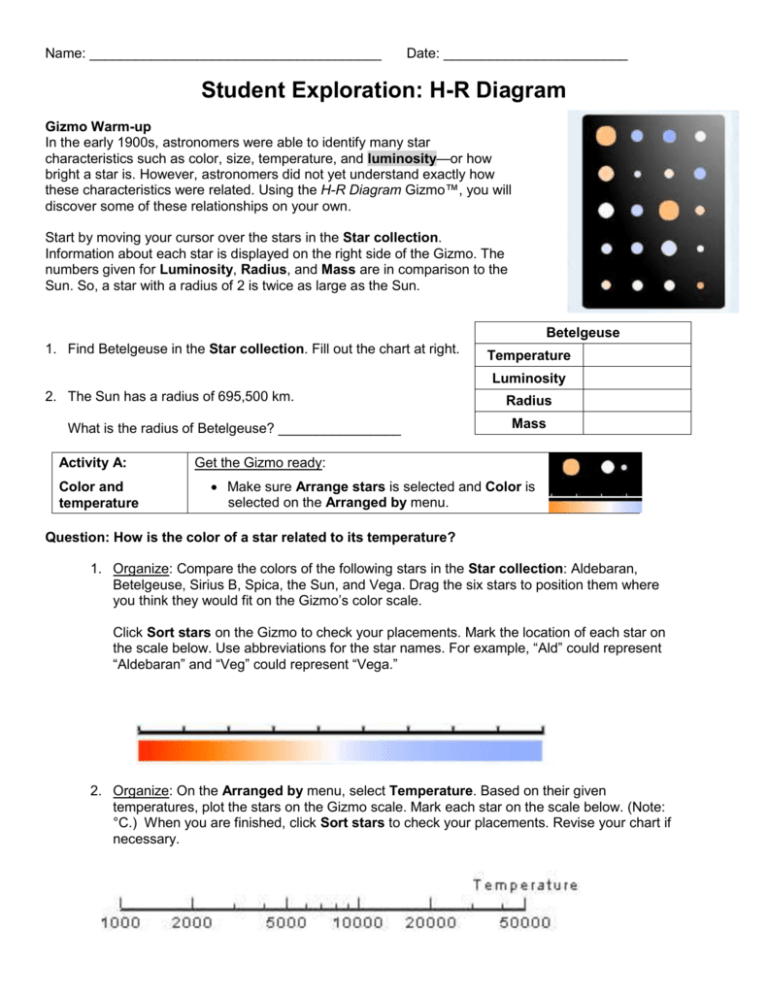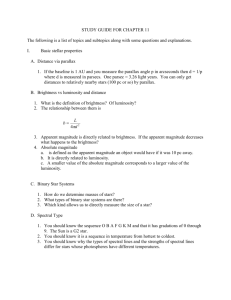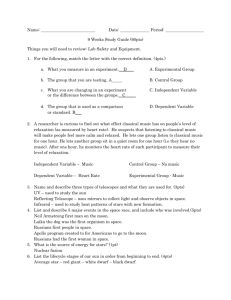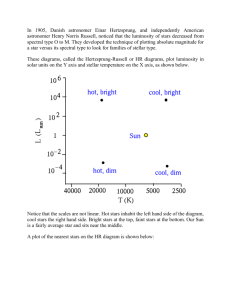H-R Diagram Worksheet: Star Properties & Classification
advertisement

Name: ______________________________________ Date: ________________________ Student Exploration: H-R Diagram Gizmo Warm-up In the early 1900s, astronomers were able to identify many star characteristics such as color, size, temperature, and luminosity—or how bright a star is. However, astronomers did not yet understand exactly how these characteristics were related. Using the H-R Diagram Gizmo™, you will discover some of these relationships on your own. Start by moving your cursor over the stars in the Star collection. Information about each star is displayed on the right side of the Gizmo. The numbers given for Luminosity, Radius, and Mass are in comparison to the Sun. So, a star with a radius of 2 is twice as large as the Sun. Betelgeuse 1. Find Betelgeuse in the Star collection. Fill out the chart at right. Temperature Luminosity 2. The Sun has a radius of 695,500 km. What is the radius of Betelgeuse? ________________ Activity A: Color and temperature Radius Mass Get the Gizmo ready: Make sure Arrange stars is selected and Color is selected on the Arranged by menu. Question: How is the color of a star related to its temperature? 1. Organize: Compare the colors of the following stars in the Star collection: Aldebaran, Betelgeuse, Sirius B, Spica, the Sun, and Vega. Drag the six stars to position them where you think they would fit on the Gizmo’s color scale. Click Sort stars on the Gizmo to check your placements. Mark the location of each star on the scale below. Use abbreviations for the star names. For example, “Ald” could represent “Aldebaran” and “Veg” could represent “Vega.” 2. Organize: On the Arranged by menu, select Temperature. Based on their given temperatures, plot the stars on the Gizmo scale. Mark each star on the scale below. (Note: °C.) When you are finished, click Sort stars to check your placements. Revise your chart if necessary. 3. Analyze: What relationship, if any, do you see between a star’s color and its temperature? _________________________________________________________________________ 4. Graph: You will now create a graph to confirm any relationships you found between a star’s color and temperature. Select Graphical plot. Using the dropdown menus at the top of the screen, select Color vs. Temperature. Position the six stars on the graphical plot. A. What pattern do you see in the graph? ____________________________________ ___________________________________________________________________ B. What does the graph show about the relationship of a star’s color and temperature? Explain. ____________________________________________________________ C. Click Move all and then Sort stars. Is the relationship still evident? _____________ 5. Infer: Naos is a star in the Argos constellation. It has a very deep blue color. What do you think is the approximate temperature of Naos? ____________________________________ 6. Apply: The flame of many stove burners is blue, but the wires of a toaster glow orange. How do you think the temperatures of these two cooking appliances compare? ______________ _________________________________________________________________________ Activity B: Luminosity, mass, and radius Get the Gizmo ready: Click Reset. Select Arrange stars. Select Luminosity on the Arranged by menu. Question: How are a star’s luminosity, mass, and radius related? 1. Organize: Position Aldebaran, Betelgeuse, Sirius B, Spica, the Sun, and Vega on the Gizmo’s luminosity scale, and mark these positions on the scale below. (Remember to click Sort stars to check your placements.) 2. Organize: Select Radius from the Arranged by menu. Position the stars on the Gizmo’s radius scale, and mark these positions on the scale below. (Remember to click Sort stars to check your placements.) 3. Compare: A. How do the stars’ luminosity compare with their radii? ________________________ ___________________________________________________________________ B. How do the stars’ radii compare with their mass? ____________________________ ___________________________________________________________________ 4. Organize: Select Mass from the Arranged by menu. Position the stars on the Gizmo’s mass scale, and mark these positions on the scale below. (Remember to click Sort stars to check your placements.) 5. Predict: Consider any relationships you see between a star’s luminosity, radius, and mass. A. As the radius of a star increases, how do you think its luminosity might change? ___________________________________________________________________ B. As the mass of a star increases, how do you think its luminosity might change? ___________________________________________________________________ C. As the radius of a star increases, how do you think its mass might change? ___________________________________________________________________ 6. Graph: Select Graphical plot. Using the dropdown menus, select Luminosity vs. Radius, and click Move all and then Sort stars. Describe any relationships you see. _________________________________________________________________________ _________________________________________________________________________ 7. Explain: Why would the size of a star affect its luminosity? __________________________ _________________________________________________________________________ 8. Compare: Select Luminosity vs. Mass, and click Sort stars. How does this graph compare with the Luminosity vs. Radius graph? __________________________________________ _________________________________________________________________________ 9. Graph: Select Mass vs. Radius, and click Sort stars. Describe any relationships you see. _________________________________________________________________________ _________________________________________________________________________ 10. Interpret: Which star do you think is the densest: Antares, Spica, or Polaris? Explain. _____ _________________________________________________________________________ _________________________________________________________________________ Activity C: Luminosity and temperature Get the Gizmo ready: Click Reset. Select H-R diagram. Introduction: In the early 1900s, two astronomers—Ejnar Hertzsprung and Henry Norris Russell—independently made a graph comparing star luminosity and temperature. This graph, now known as a Hertzsprung-Russell diagram, or H-R diagram, is still used today to classify stars into groups. Question: What does an H-R diagram reveal about star types? 1. Observe: Look at the temperature axis on the diagram. What is unusual about this axis? _________________________________________________________________________ The temperature scale goes backward because the original H-R diagram plotted luminosity vs. color, with the color ranging from blue to red. 2. Predict: How do you think the luminosity of a star is related to its temperature? _________________________________________________________________________ _________________________________________________________________________ 3. Classify: Click Move all and then Sort stars. Click COPY SCREEN and paste a screenshot of the diagram in a blank document that you will turn in with this worksheet. Circle stars that you think belong in a group together. On the lines below, explain your groupings. _________________________________________________________________________ _________________________________________________________________________ _________________________________________________________________________ _________________________________________________________________________ 4. Identify: Turn on Show star groups. A. Which group are most stars found in? _____________________________________ B. How would you characterize stars in this group? ____________________________ ___________________________________________________________________ ___________________________________________________________________ (Activity C continued on next page) Activity C (continued from previous page) 5. Describe: More than 90 percent of all stars in the universe, including the Sun, are main sequence stars. As main sequence stars age, they move up and to the right on the H-R diagram and become giants or supergiants. Giants and supergiants form when the center of a star collapses and its outer parts expand outwards. What are the characteristics of giants and supergiants? _____________________________ _________________________________________________________________________ _________________________________________________________________________ 6. Compare: Study the H-R diagram. A. Which stars are white dwarfs? __________________________________________ B. What are the characteristics of white dwarfs? _______________________________ ___________________________________________________________________ ___________________________________________________________________ ___________________________________________________________________ White dwarfs are small, hot stars that are near the end of their lives. They are the leftover cores of giants and supergiants. 7. Classify: Proxima Centauri is the nearest star to the Sun. It has a luminosity of 0.000138 and a temperature of 2,767 °C. A. Which star group does Proxima Centauri belong to? _________________________ B. On the H-R diagram, which star would Proxima Centauri be near? ______________ 8. Describe: Locate the Sun on the H-R diagram. How will the Sun’s luminosity and temperature change as it ages? How will these changes affect its position on the diagram? _________________________________________________________________________ _________________________________________________________________________ _________________________________________________________________________ _________________________________________________________________________ _________________________________________________________________________









